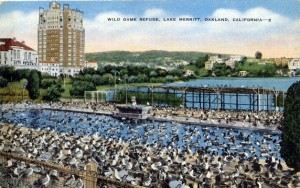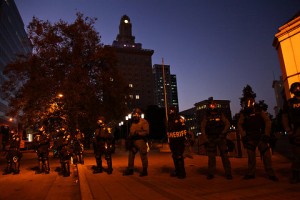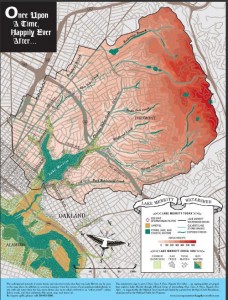
Lake Merritt Wildlife Refuge. Postcard published by Gilboy Agency, Oakland, California. Printed by E.C. Kropp Co, Milwaukee, Wisconsin.
There is a bird refuge in Oakland, in the middle of an algae-laden tidal lagoon that everyone calls a lake. Established in 1870, it is the oldest wildlife refuge in North America. Nearly ninety species of bird live at Lake Merritt. In the summer months, the goose population there reaches nearly two thousand; during the fall, cormorants number in the hundreds. The birds’ home is in the country’s fifth most dangerous city, a place that often gets national media attention for its militant police force, prevalence of teenage prostitution and child sex trafficking, gang violence, and ongoing civil unrest.

Oakland police in Oscar Grant plaza in front of Oakland City Hall. Photo by Jim Wilson. Courtesy the New York Times.
A wildlife refuge in such an environment may seem like a contradiction, and in some ways it is—one of countless that hold Oakland together. Though we may imagine a city as a unified whole, all cities are composed of multiple parts, often formed in contradistinction to one another. Oakland has spaces of both beauty and decay, of nature and artifice, of safety and danger. One area has parks and gardens because another is littered with industrial waste; it has a network of hiking trails in the hills because the flatlands are covered with asphalt. One neighborhood may have very little criminal activity precisely because another has a disproportionate amount. No landscape develops in isolation, and all landscapes hold within them a contrary, opposing one.

At the Lake Merritt Wildlife Refuge, the law is on the birds' side. Photo courtesy the author.
The Lake Merritt wildlife refuge is no exception. Like a gated community, this zone of ordained safety was formed in opposition to its environs. When it was signed into existence, it was legal to kill birds and other wild animals in Oakland. The refuge was a necessary ordinance, a declaration of safety within a surrounding area of danger. This is what refuge means: it not only refers to a place of reprieve but also to one of hazards and risks, a place from which rescue has been necessary. The word encompasses two conceptually opposed spaces, a semantic reminder of the way every landscape suggests its opposite.

Map of the Lake Merritt watershed by artist Scott Oliver. Courtesy the artist.
Artist Scott Oliver’s public art project Once Upon a Time, Happily Ever Afteris an interpretative tour of Lake Merritt that traces the multiple narratives that contribute to our experience of the site. Presented in the form of podcasts and a series of plaques situated around the lake, the project draws our attention away from our direct experience of the lake so we may return to it with new insight. The audio tour interweaves readings, interviews, and distant histories with sounds of the lake’s waterfowl. Maps of the lake’s watershed and the storm drains that feed it express its physical dependence on places afar. By highlighting the lake’s relationships with things beyond its boundaries, the artist asserts that those interactions are as crucial to its identity as what lies within its immediate vicinity.

A diagram illustrating Lake Merritt's watershed, by Scott Oliver, is installed along the lake's three-mile perimeter. Photo courtesy the author.
Oliver chronicles the myriad social interventions that contribute to the existence of this “natural” space. He tells stories from recent times and from long ago—about the artist who carved a labyrinth along the shore in 1992 and about Samuel Merritt, who commissioned the construction of the dam that transformed the tidal estuary into a lake in 1870. He tells us about the nature center and the manmade bird islands and the dwindling municipal funding that has led to their slow decay. By interweaving these supposedly contrary forces—nature and society—into a single strand, he reminds us of the ways sites are filled with juxtapositions, contrary pieces whose jagged edges come together to create a whole.

Lake Merritt, 1884. Photo courtesy California Digital Archives. Photo research, Dan Lipsitt.
There is a wildlife refuge in the country’s fifth most dangerous city, and sometimes this doesn’t feel like a contradiction at all. On Sunday nights I walk down to the lake, less than half a mile from my apartment, and I stare at trees full of black-winged seabirds, at mallard ducklings huddling close to their mom, at pelicans preening on manmade islands. I stare and ponder; I consider the night heron’s legs tucked under its body, admire its motionless stance that makes it seem prepared for anything. I sit by the fountain, notice a Big Gulp cup floating near the shore, and make sure I walk home before dark.




